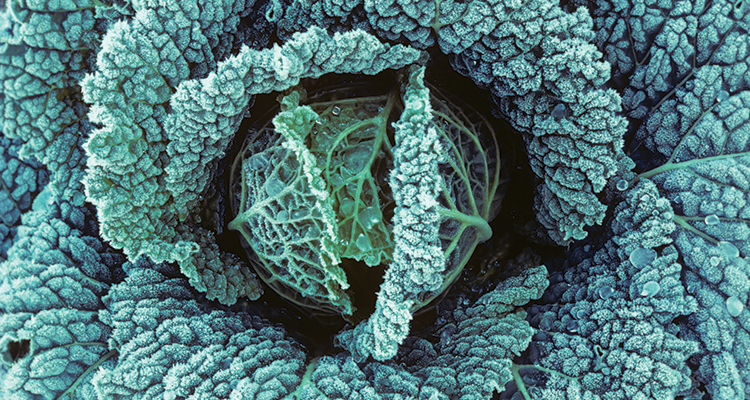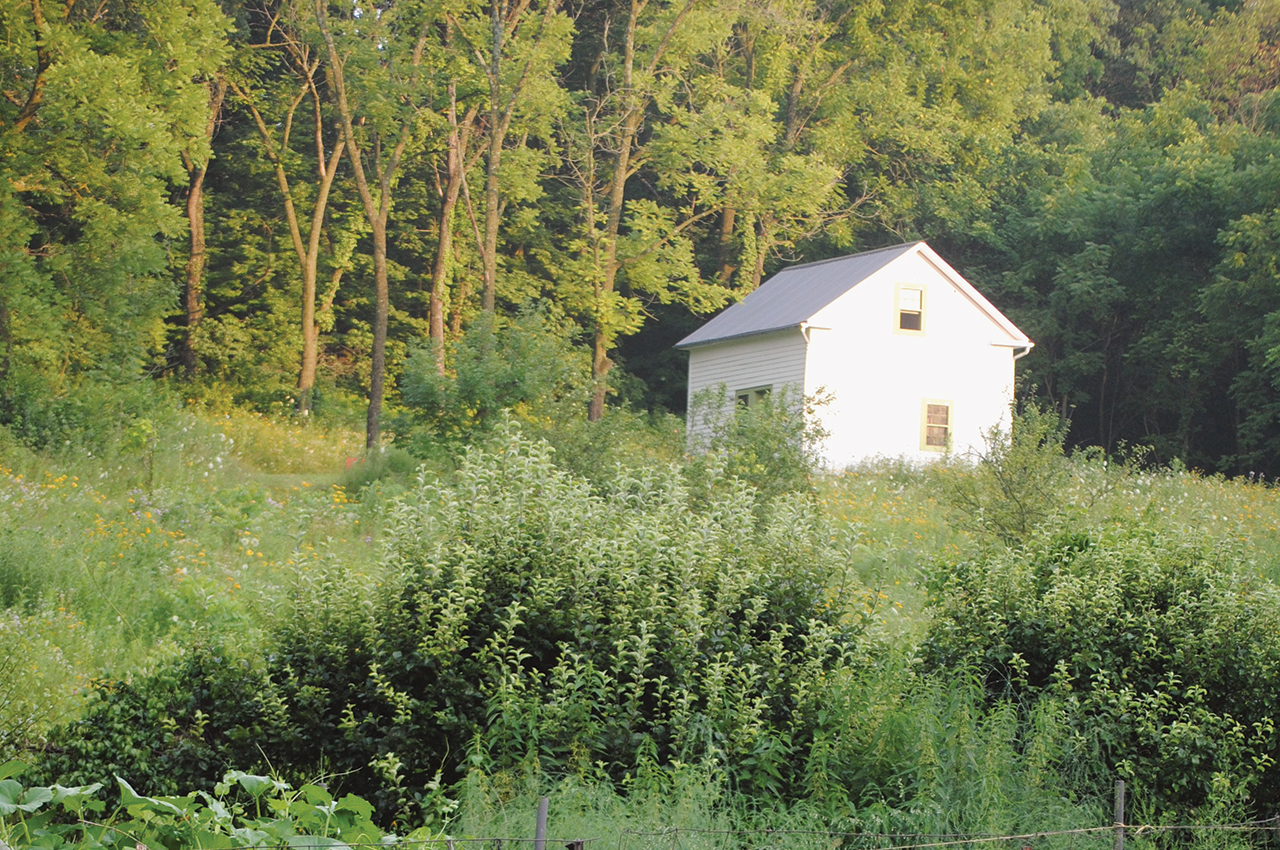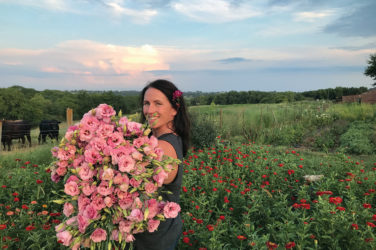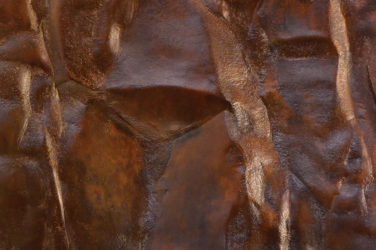Above: A cabin provides a refuge from the summer sun on this lush slope in the Cavagnaro gardens near Decorah.
Writer: Veronica Fowler

For the past 30 years, David Cavagnaro has been quietly planting, eating, photographing—and living—a revolution.
He was farm-to-fork before anyone even thought that phrase up. He was living a sustainable lifestyle long before it was a thing. And the Decorah gardener extraordinaire was a locavore before those words ever slipped from a hipster’s lips.
Cavagnaro, 79, is lean and leathery, a reflection of the steady diet of organic produce he grows and the hard physical work of maintaining 155 acres, the heart of which is nestled into a scenic valley eight miles northeast of Decorah.
He’s an energetic, restless man who can hardly sit still, not when there is brush to pick up in the vineyard or pruning to be done on his 30 fruit trees, or planting out in the greenhouse, or weeds to tackle in his vegetable garden, which spans an acre. Another four acres are in those fruit trees, as well as grapevines, herbs and wildflowers. The rest is open fields and woodlands, which Cavagnaro manages on his own, chain saw in hand, for optimal forest health and to feed his wood-burning furnace.
Apparently, no one told Cavagnaro that in your eighth decade, you’re supposed to slow down.
“I’m growing out 200 varieties of tomatoes,” he says, laughing and shaking his head. “Who needs 200 varieties of tomatoes!”

Seed Savers Exchange
Cavagnaro grew up in the San Francisco Bay area, roaming and reveling as a boy in its stunning wild areas in the days before they became prime real estate. As a young man, he cultivated an acreage in California, and then moved to Decorah in 1987, attracted by a nonprofit that was then just fledgling but is now an institution: Seed Savers Exchange.
Moving to Iowa, he says, “was like dying and going to heaven.” He loved the California of his youth, but the influx of development, traffic, money and environmental degradation was intolerable: “I could no longer stand to see everything I loved destroyed and money paving over everything.”
Small-town Iowa life, with its lack of big development, its ease in getting around, and its open, friendly people, was exactly what Cavagnaro and his then-wife and child were looking for.
He also loved his work at Seed Savers. Established in 1975, it grows, saves and shares heirloom seeds in an effort to protect biodiversity and preserve heirloom varieties. It houses a seed bank of more than 20,000 rare, open-pollinated varieties. But seeds can’t last in storage forever. So it relies on worldwide members to assist in periodically planting and then collecting the fresh seeds and storing them so they can be grown out again.
At Seed Savers, Cavagnaro’s photography skills flourished. He created iconic images that celebrated the gorgeous, unique heirloom fruits and vegetables that surrounded him. He was also photographing what he was growing in his extensive home garden. He left employment at Seed Savers in 1996 but continues to advise and volunteer there.
Garden Photography
His photography work and growing photo library eventually made him one of the most in-demand garden photographers in the country. He long ago lost count of how many books he’s been published in, but estimates it at about 200. He’s also published five photography books of his own and has published in many national gardening and home magazines.
His land became a living studio. Each year, he planted (and continues to plant) hundreds of different cultivars of nearly every annual vegetable and flower imaginable, with an emphasis on heirloom varieties that he then saves seeds from. It has enabled him to photograph an astounding variety of flowers, trees, shrubs, herbs, vegetables, fruits and other plants at precisely their peak in ideal weather and light conditions.
Between his work at Seed Savers and his photography, Cavagnaro has played an important role in introducing the public to the pleasures of heirloom tomatoes. The fact that you can now walk into most better U.S. supermarkets and purchase heirloom tomato mixes and cultivars is due, in no small measure, to Cavagnaro’s work.
The anchor of Cavagnaro’s sprawling landscape is a beautiful 4,300-square-foot house, built a quarter-century ago. It features extensive native limestone, cut and crafted by a British stonemason who lives in the area. Inside, the spacious kitchen contains a wood-burning stove, as well as a traditional oven, and a layout designed for massive amounts of food processing and preservation—drying tomatoes, canning peaches, freezing pesto. Its generously sized windows were designed with ample sunlight for plants in mind, and they’re the perfect spot for lime, kumquat, lemon, tangerine and fig trees to grow all season long and bear abundant fruit. The north-facing timber frame deck overlooks the spectacular valley and plantings. In summer, its pergola is draped with grapevines, making it the perfect site for a glass of wine or summer feast of just-picked produce.
On the ground level, there’s a garden room exclusively for potting and saving plant seeds and cuttings, as well as a root cellar that naturally keeps the garden’s bounty fresh for months.
In fact, Cavagnaro, who also has goats and chickens, estimates that he is 98 percent food self-sufficient. He has to purchase only coffee, sugar, tropical spices, bacon, bananas and white flour. (He grows and grinds his own wheatberries for whole wheat flour.)
Pepperfield Project
Rather than take what could be his retirement years to, well, retire, Cavagnaro has instead taken on even more. A little over a decade ago, he bought and moved an 1851 log cabin to his property and restored it.
That restoration prompted the creation of the Pepperfield Project (pepperfieldproject.org), an educational nonprofit where, he says, “people could experience good food and how to grow it, and where they could expand themselves personally among gardens surrounded by Iowa’s beautiful natural wilds.”
Cavagnaro’s home, gardens and outbuildings have all been donated to the nonprofit, which offers a range of classes, workshops, retreats and events. It also is the location of periodic educational-themed dinners, which feature the garden’s abundant produce and quickly sell out.
And as if that’s not enough, Cavagnaro has also committed to overseeing and caring for a one-acre garden at the local hospital, Winneshiek Medical Center, so that patients, staff and visitors have a ready supply of fresh, organic produce.
At home, he remains furiously busy, planting and saving seeds and harvesting and feeding his many visitors and helpers, including interns who might live in the log cabin or a tiny house recently built on his land.
Cavagnaro has no plans of slowing down: “Why or even how would you give up your passions? If you’re passionate about something, you do it until you drop. I’m doing all the things I love.”
Heirloom Vegetables to Try

Why settle for the same old mass-distributed seedlings each year? Here are some heirloom varieties worth trying. All are available at seedsavers.org.
“Romano Pole” green beans: long, flat beans that are tender and delicate.
“Bright Lights” Swiss chard.
“Five Color Silverbeet” Swiss chard: delicious and so beautiful you can plant it among your flowers.
“Diamond” eggplant and “Feher Ozon Paprika” sweet peppers: the earliest and most productive of their type for the upper Midwest.
“Sibley” winter squash: an Iowa variety that’s exceptionally tasty.
“Tomato Amish Paste:” excellent, all-purpose tomato with excellent flavor.
“Blacktail Mountain” watermelon: one of the few that are reliable this far north.







